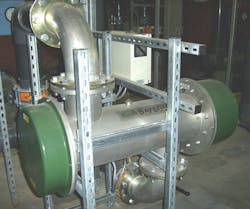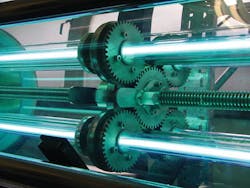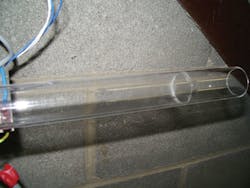Second generation UV disinfection solves fouling problems
Malcolm Snowball of GB Environmental published the first definitive paper on the germicidal kill mechanism in 1988 and was one of the three scientists who originally discovered that ultraviolet (UV) light at certain wavelengths killed Cryptosporidium. His comments on the impact of second-generation designs…
Malcolm Snowball
An abundance of scientific data proves the effectiveness of the germicidal waveband of Ultraviolet (UV) “C” in the fight against numerous waterborne pathogens; however UV disinfection continues to be met with skepticism. This is due in part to lack of customer knowledge of the technology, but mostly because of the shortcomings of earlier equipment from numerous manufacturers.
The latest equipment from UK-based company GB Environmental has been specifically designed to address the problem, providing reassurance that UV disinfection is a simple and elegant way of disinfecting water.
Aptly named SafeGuard, GB Environmental’s second-generation UV water disinfection chambers provide a robust and reliable form of chemical-free disinfection. Its consistent kill performance and minimal manual intervention required makes this UV disinfection technology reliable, low maintenance, and cost effective.
The majority of skepticism has been borne out of a combination of incorrect sizing and lack of sufficient means to keep UV lamps free from fouling. Inevitably, as water passes through any UV disinfection chamber, proteins, oils, fats, general debris, minerals and other calcination products in the water leave deposits on the quartz forming a homogenous film. It is paramount that a cleaning mechanism is in place to remove this film. The film will absorb most of the UVC radiation and will render the disinfector useless. The whole objective of a UV disinfector is to get the destructive wavelengths to the microorganism and kill it. If the destructive wavelengths are prevented from doing this the microorganism passes through the disinfector unharmed. Systems with inadequate cleaning mechanisms are severely compromised since UV only kills microorganisms by disrupting their DNA upon direct illumination.
Manufacturers of UV disinfection equipment tend to use a simple sleeve that will automatically slide along each quartz tube at timed intervals. Analysis by GB Environmental found that such cleaning mechanisms tend to work on loosely held particulate, but are ineffective on the softer constituents of the film, namely the oils, fats and proteins, which they spread across a larger surface area of the quartz tube. This has a shielding effect, reducing the ability of UV rays to pass through the quartz and into the water. The analysis found that proteins act as the “glue” which gathers and binds other particles that tend to rapidly build up the film.
To counteract this, all the SafeGuard UV water disinfectors have a patented planetary, fully automated cleaning system incorporating revolutionary Tioxispring™ cleaning technology. Its unique catalytic oxidation process uses cleaning heads that revolve around the lamps and react with fouling materials to keep the tubes clean without the addition of chemicals, even in hard water areas. The photograph (A) shows a sleeve that has just been removed after 12 months of continuous service in a notoriously hard water area. The tube is spotless except for its extremities at the ends of the cleaning head travel.
The Tioxispring™ cleaning mechanism contains four fluorocarbon segments, which are sprung loaded around each quartz sleeve, providing a scraping and raking action across the surface of the sleeve, while being driven both radially and axially along it.
As each part of the quartz tube passes through the cleaning mechanism, the two Tioixsprings produce a unique catalytic process that cleanses the tube of any remaining fouling. Since the springs are catalytic oxidizers, which function as an aggressive chemical free cleaner, any debris attaching itself to the surface of the quartz is broken down by the oxidation process.
The radiation intensity from a UV lamp falls off proportionally to the square of the distance from the lamp, therefore it is important that all microorganisms are exposed as close to the lamps as possible to get maximum disinfection effect. To achieve this, it requires the water flow through the reaction chamber to be highly turbulent at low-pressure drop.
The geometrical profile of GB Environmental’s cleaning mechanism acts as a static mixer producing highly turbulent flow with a low pressure drop. The combination of increased turbulence and low-pressure drop continuously draws the microorganisms closer to the lamps in a controlled manner. This ensures the microorganisms are vigorously rotated, allowing for the UVC wavelengths a multitude of attack angles to destroy their DNA.
The cleaning process should be fully automatic initiated from the radiation detector when the radiation falls below a preset limit or from a timer that initiates the cleaning cycle every set period of time. If care is taken in sizing and applying the UV disinfector to the application correctly, it will provide a highly consistent biological kill performance with minimum maintenance and service.
Unfortunately, UV disinfection units have been sized incorrectly. Where this has been the case there is little that can be done to make the UV disinfection work, apart from changing it to the correct size, which is both costly and disruptive. Best practice procedures must be followed in order to size units appropriately – it is imperative that maximum water flow rate, degree of transmissivity at 254 nm through the liquid, and the number and type of microorganisms to be disinfected, are all taken into account.
In much the same way as you would not expect to buy a new car that has not been crash tested, UV disinfection equipment must be sized according to the worst case scenario. Each Safeguard UV disinfector is sized for the dose delivered using Averaging Point Source Summation Technique for delivered radiation intensity. This is a complex mathematical calculation, calculated at the worst point in the reaction chamber under maximum water flow conditions with lamps at the end of their life. GB Environmental makes the calculation with one lamp out with an additional safety margin added to the sizing calculation, which reinforces the safety of the chosen UV technology.
Three critical components of this calculation are explained. First, lamp power at the germicidal wavelengths (220nm to 280nm) is dependent upon the lamp type and how the lamp drive (ballast) operates the lamp. Second, it is important that transmissivity (a measure of the water’s ability to transmit UV light at the germicidal wavelengths) is measured appropriately, since certain contaminants in water can prevent UV light from effectively transmitting through the water, reducing the UV dose that reaches microorganisms. Transmissivity tests need to be conducted long enough in order to get the right reading and must be conducted in the worse possible conditions. Thirdly, the chamber must be sized according to the peak liquid flow in the chamber, since this governs the retention time component of the dose formula, which is worked out using the general formula below:
Dose D = I x t = mj/cm2
“I” is the intensity at the worst position in the chamber and “t” is the retention time of the liquid passing through the chamber.
Obtaining the right information and calculating the correct size of UV chamber required is clearly a prerequisite for the installation of any UV germicidal barrier technology. However, there has been much debate regarding the type of UV lamps used.
A wide variety of lamps are used in UV disinfection, although broadly speaking the most commonly used lamps tend to fall into three categories; low pressure mercury discharge lamps, amalgam lamps, and medium pressure mercury discharge lamps. All three effectively act to kill pathogenic waterborne microorganisms, although some are better suited to treat different types of water flow.
The majority of GB Environmental’s second generation UV lamps are amalgam due to their high efficiency, low running costs, low skin temperature, and longer life than medium-pressure alternatives. The amalgam lamp provides an economical way of disinfecting water with high reliability. Their cool operation also ensures that they tend not to be prone to rapid fouling, which often results when the quartz sleeve encasing the lamp rises in temperature.
However, just as no one sized chamber fits all, the same is true for the type of UV lamps required to adequately disinfect water. If for example the choice is between Amalgam lamps and Medium Pressure lamps for a body of water to be treated in a large drinking water treatment plant (in excess of 180ML/day), medium pressure mercury discharge lamps would be the most suitable, since their high UV germicidal output over the entire germicidal range 220nm – 280nm provides the smallest footprint per cubic meter of treated water, albeit at a substantially higher running cost.
An area that is neglected when it comes to reactor design is that of radiation monitoring. The ideal detector would be microorganism size placed near to the chamber wall at the farthest position from the lamps. It would have a detection surface which was unaffected by the highly energetic UV radiation and be low cost. Unfortunately the device has not yet been invented so we have to work with what we have available, i.e. photo diodes or vacuum photo tubes. These devices have two-dimensional measuring surfaces and are trying to measure a three-dimensional radiation; therefore they need some mathematical treatment to make sense, i.e. averaging point source summation. If the readings are to be relied upon, then the detector window must be kept clean (just like the lamp sleeves need to be kept clean) and must have an automatic cleaning mechanism. The detector window on the GB Environmental unit is cleaned every time the lamp sleeves are cleaned.
Author’s Note
Malcolm Snowball is the technical director of GB Environmental, based in Chelmsford, Essex, UK. For more information, contact: www.gb-environmental.co.uk




